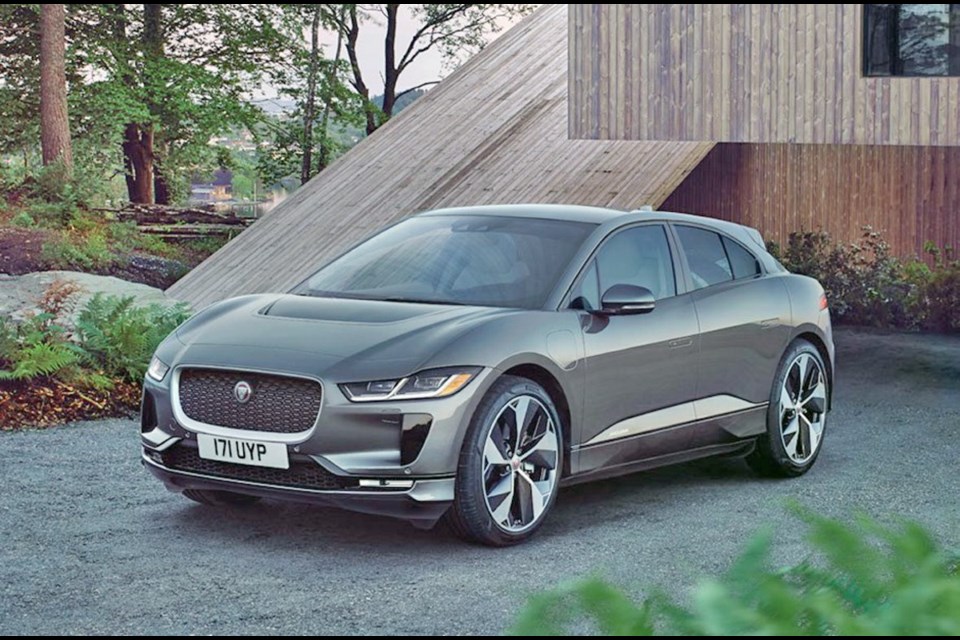Jaguar, a luxury brand that has produced some of the world’s most memorable cars, has just added another milestone to its history — the I-Pace, its first all-electric vehicle.
Many manufacturers have electrified their fleets and luxury marques all offer a model or two with battery assist.
Jaguar has decided to jump into the market with gusto, with a pure Battery Electric Vehicle.
In doing so, it has also become the first manufacturer to rival Tesla and its line of all-electric offerings.
True to its heritage, the I-Pace is a performance car, with a 4.8-second 0-100 km/h dash, thanks to two electric motors (one on each axle) producing 394 horsepower and 512 pounds-feet of torque. It boasts a 200 km/h top speed.
The I-Pace is equipped with a 90 kWh lithium-ion battery, which will give drivers a 377-kilometre range on a charge. It can recharge using a 50 kWh rapid charger, achieving 270 kilometres of range in an hour, according to Jaguar.
It is available in three trim models, starting at $86,500 for the S and up to $96,500 for the HSE.
I had an opportunity to drive the latter at an event in Ontario.
As I walked up to the I-Pace for the first time, the thought that came to me is that this vehicle might set the new standard for electric vehicles.
Of course, Tesla comes to mind, with the Tesla X as its closest competitor. But what one experiences with the Jaguar is its deep history, its promise of being coddled in the lap of luxury while hurtling effortlessly on the open road.
But perhaps the I-Pace is the bellwether of where the luxury-car segment will be in the years to come.
As I reached the I-Pace, the flush door handles popped out, reminding me of the subtle differences between the electric car and its cousin, the F-Pace, which has a regular built-in door handle.
The cabin combines acres of glass that light up to reveal electronic gauges, controls and instruments. Driving information is front and centre, of course, with a floating centre console that houses the cabin comfort controls.
True to its driving roots, the seats are immensely comfortable, while supportive. The driving position is spot-on and the steering wheel falls easily to hand.
Fit and finish is what you would come to expect of a car of this calibre, with upscale pieces and soft materials never far from eyes or hands.
Buyers can individualize their I-Pace to their exacting needs and desires, but check too many of the option boxes and the price of the vehicle quickly spirals upward.
Still, with a list price comparable to competitors who just offer a gasoline engine, one can sometimes indulge on trivial features and still stay close to one’s budget.
The cabin is more spacious than a Porsche Macan, thanks to a body width that is almost 150 mm wider and a wheelbase 67 mm longer.
Along with a rear cargo space of 656 litres with the back seats up, the I-Pace also boasts an extra 27 litres found under the hood (remember, there is no gas engine anymore).
A press on the start button and all the lights and gauges wake up. There is no sound.
Find an empty stretch of road, stomp down on the accelerator pedal and the I-Pace leaps forward like a scalded cat (I had to get a big cat analogy into a story about Jaguars somehow). There is no drama and torque is instantaneous.
Obviously, you’re not going to see 377 kilometres if you keep doing this, but it is so much fun. There is no turbo lag, there is no shifting up and down in gears — and there is almost no sound.
One thing you do feel is the 2,670 kilograms of vehicle weight (by comparison, the F-Pace 25t weighs a mere 1,760 kg).
Despite the extra bulk, the I-Pace acquaints itself well to spirited driving. Credit has to be given to a lower centre of gravity (because of the batteries placed under the floor) and out tester being equipped with the Adaptive Dynamics package. This package includes electronically controlled dampers to optimize the suspension under different road and drive conditions.
The I-Pace comes with all-wheel-drive, but don’t expect it to be an off-roader. Having said that, expect it to be good in the snow because of its weight and ground clearance enhanced because there are no exhaust components to worry about.
At the end of the day, it is hard to hand the keys back. The I-Pace is not a car for the masses, with its $86,500 starting price. It is a premium vehicle competing against similar up-market offerings.
But if you were shopping for a luxury car, the I-Pace makes for a compelling reason to finally put the internal combustion engine to rest. You still get grace, pace and space (a slogan used by Jaguar in the 1950s and ’60s), but you now get bragging rights to being the first to electrify your future.
THE SPEC SHEET
Type: Luxury SUV, Battery Electric Vehicle, dual motor, all-wheel drive
Engine: One electric motor on each axle, 394 hp at 4,250 r.p.m., 512 lb-ft of torque
Battery: 90 kWh
Charging time @ Level 2: 12.9 hours (from zero)
Range: 377 km
Transmission: One speed
Dimensions (mm):Length, 4,682; width, 2,011; height, 1,565; wheelbase, 2,990
Curb weight (kg): 2,670
Price (base/as tested): $96,500/ $100,525 (includes $1,750 freight, $495 PDI and $100 AC tax)
Options: Black exterior pack $180, cold climate pack $550, front fog lights $110, cabin air ionization $110, adaptive dynamics $720,
activity key $210
Tires: 255/50 R 20 on alloy wheels
Fuel type: Electricity
Warranty: Four years/80,000 km new car and roadside assistancet



